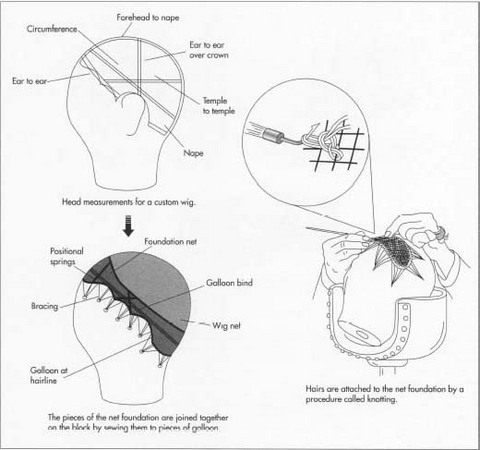Uncategorized
Raw Materials
By the early 1900s, jute fibers were being used as imitation hair in theatrical wigs. Today, a favorite material for theatrical wigs, particularly those worn by clowns, is yak hair from Tibet. The hair of this ox species holds a set well, is easily dyed, and withstands food and shaving cream assaults.
Wigs of synthetic (e.g., acrylic, modacrylic, nylon, or polyester) hair are popular for several reasons. They are comparatively inexpensive (costing one-fifth to one-twentieth as much as a human hair wig). During the past decade, significant improvements in materials have made synthetic hair look and feel more like natural hair. In addition, synthetic wigs weigh noticeably less than human hair versions. They hold a style well—so well, in fact, that they can be difficult to restyle. On the other hand, synthetic fibers tend not to move as naturally as human hairs, and they tend to frizz from friction along collar lines. Synthetic hair is also sensitive to heat and can easily be damaged (e.g., from an open oven, a candle flame, or a cigarette glow).
Human hair remains a popular choice for wigs, particularly because it looks and feels natural. It is easily styled; unlike synthetic hair, it can be permed or colored. During periods of scarcity of cut human hair for wigs, manufacturers have used combings (hairs that fall out naturally at the end of their life cycle). However, actively growing hair that is cut for wigmaking is preferred. United States wigmakers import most of their hair. Italy is known as a prime source of hair with desirable characteristics; other colors and textures of hair are purchased in Spain, France, Germany, India, China, and Japan. Women contract with hair merchants to grow and sell their hair. After cutting, the hair is treated to strip the outer cuticle layer, making the hair more manageable. Wigmakers pay $80 or more per ounce for virgin hair, which has never been dyed or penned; a wig requires at least 4 oz (113.4 g) of hair.
Some manufacturers blend synthetic and human hair for wigs that have both the style-retaining qualities of synthetic hair and the natural movement of human hair. However, this can complicate maintenance, since the different types of hair require different kinds of care.

